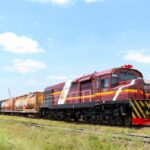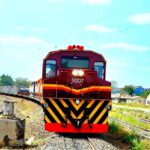The history of rail transport in Kenya dates back to the period between 1891 and 1895 when raging debates ensued in the British parliament over the necessity of constructing a railway line through a country owned by the Maasai and unlettered African tribesmen.

Premonition
By all means and at all costs, the line was destined to happen. Syokimau, a Kamba medicine woman and prophetess had foretold the coming of a long iron snake belching fire and smoke as it slithered from the Indian Ocean and winding its way across the plains and highlands to an unknown destination. As she divulged her prophecy, she said strangers with red wiry hair would come with the snake and they would bring change. Not even the British aristocrats who were feuding within the precincts of the House of Commons could stop it.
Construction
Building Railways in Africa can present tough challenges. The case of the Lunatic line was exceptionally challenging. It was as if the spirits of the land had risen up in opposition to the epic undertaking. Actual construction work began on May 30, 1896.
But it was way more difficult than anyone might have anticipated. First the mosquitoes struck and having tasted the foreign blood, they were unrelenting as they deposited the malaria venom into the Indian workers and British Engineers. Dysentery and small pox too wreaked their own havoc on the Railway workforce. The fact that there were no elaborate health establishments made it worse.
As if diseases were not enough, the unpredictable terrain played a role too in hindering progress of the construction process on numerous occasion. work had to stop as the British Engineers plotted on the best approach to the numerous challenges post by the unfriendly terrain. The Great Rift Valley was daunting challenge to the construction. It required great innovation on the part of the engineers in order to maneuver pat the mammoth challenge.
Resistance and hostility from the inhabitants of the localities the line traversed was a constant road block throughout the construction period. The locals took great exception to the British engineers and Indian Coolies and carried out disruptions in an organized manner which extensively slowed down the pace of the construction. In expressing their distaste for the British Engineers and Indian Coolies, the locals would vandalize the laid sections of the line, loot the construction materials and also carried out direct attacks on the construction workers. To minimize this hostility, the British rulers entered into peace treaties with the locals. On the other hand, the Indian Coolies set up dukas and engaged in barter trade with the locals. These two initiatives softened the hard stance taken by then locals to a great extent and with time locals were also engaged in construction as unskilled labour.
Nairobi
By 1899, construction reached Nairobi which was then a habitat for the Maasai pastoralists. It was called Nyrobi meaning the place of cool waters and was nothing more than an expansive swamp. Chief Eng. George Whitehouse proposed the site as the ideal resting place for the construction workers due to its high elevation and temperate climate. A railway depot and camp were built and from this humble beginning, the City under the sun was birthed. It grew rapidly to replace Mombasa as the capital of Kenya. The first ever images of Nairobi depict a railway estate with railway houses, offices, the station and workshops.
Despite the challenges, Chief Eng. George Whitehouse and his troops successfully rammed the Railway line into East Africa’s interior. Several shaky wooden trestle bridges, unpredictable terrain, hostile tribes, prohibitive cost, disease infestations, man-eating lions, backbreaking efforts amongst other setbacks later, construction of the line culminated at Kisumu which was then known as Port Florence in 1901.
The feat had taken 200,000 rails, 200,000 fish plates, 400,000 fish hooks, 1.2 million sleepers and 4.8 million steel keys. On the downside, approximately 2,500 lives were lost. Without a doubt, it was one of the most daunting engineering feats the world has ever witnessed.
Birth of a Nation
The Uganda Railway emerged as one of the most famous railway lines in the world. Interestingly, it is the only railway line which has more than one name. It was christened the Uganda Railway then later referred to as the Permanent Way, The Iron Snake and most famously as the Lunatic Line.
The line had such a profound effect on our country and is the greatest contributor to the fruits of economic prosperity we enjoy today. It is this railway that extensively epitomizes the birth and growth of Kenya as a nation. In the wake of its path during construction, it gave birth to settlements and encouraged trade. After completion of construction, development blueprints were planned along the lines path leading to the establishment of the Northern Corridor; the region’s trade route with the highest economic potential.
Important Dates In the Railway History
- 30th May 1896: Beginning of construction of Uganda Railways.
- 1899: Rail head reach Nyrobi, name later changed to Nairobi.
- 1900: The line reached Nakuru.
- 19th Dec,1901: Rail line completed and reached Port Florence now named Kisumu.
- 1915: Completion of Konza to Magadi line.
- 1920: Voi to Taveta line completed.
- 1924: The line reached “64” (Now Eldoret).
- 26th Feb 1926: Name Uganda Railway changed to Kenya and Uganda Railways.
- 27th Dec 1927: Became Kenya and Uganda railways and harbours.
- 12th Aug 1929: Present Headquarters Building opened.
- 1930: Nairobi to Nanyuki line completed.
- 14th Jan 1931: Jinja Kampala line opened connecting through to Mombasa.
- 1932: Kisumu to Butere line completed.
- 1st May 1948: Became East Africa Railways and Harbours.
- 1950: Nairobi is made a city.
- 1st June 1969: East Africa Railways Corporation established.
- 1977: End of East Africa Railway Corporation Administration.
- 20th Jan 1978: Present Kenya Railway Corporation was formed through an Act of Parliament.
- 1st Nov 2006: Kenya Railways goods and passenger services conceded to Rift Valley Railways.
- 1st Jan, 2015: Actual construction of the Nairobi – Mombasa Standard Gauge Railway line commenced.
- 30th May, 2017: Commissioning of the Madaraka Express Freight Services at Port Reitz Freight Station.
- 31st May, 2017: Commissioning of the Madaraka Express Passenger Services between Mombasa and Nairobi.
- 19th October, 2019: Launch of the Madaraka Express Passenger Services between Nairobi and Suswa station.
- 17th December, 2019: Launch of the Madaraka Express Freight Services to the Naivasha Inland Container Depot.
- November 10, 2020: Commissioning of the Kenya Railways Transit Shed, Diesel Multiple Unit trains and Refurbished Nairobi Central Railway station.
.





